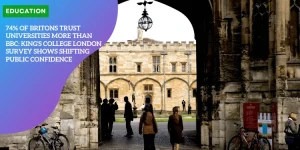Reimagining Higher Education: 8% STEM Job Growth Demands Urgent Investment Reform
The Current Higher Education Landscape
Growing Mismatch Between Traditional Degree Offerings and Market Demands
Higher education institutions have always strived to offer a broad range of academic disciplines, adapting to the evolving needs of society.
Yet, there’s a noticeable gap between the degrees offered and the job market’s demands.
Traditional degree programs, while enriching and valuable in many respects, do not necessarily guarantee employment in today’s dynamic job landscape.
As industries quickly evolve, the demand for STEM (Science, Technology, Engineering, and Mathematics) skills has significantly increased.
Despite this shift, many universities still place a greater emphasis on liberal arts and other less market-relevant courses.
This creates a pool of graduates who struggle to match their education with the available job opportunities.
Disproportionate Funding Allocation Favoring Traditional Curricula Over STEM
The allocation of funding in higher education has not kept pace with the changing demands of the job market.
A significant portion of financial resources continues to be directed towards traditional curricula and liberal arts programs.
While these disciplines are crucial for a well-rounded society, this imbalance often results in lower post-graduation employment rates for students in these fields.
Emerging sectors, which are hungry for skilled STEM professionals, are left underfunded, exacerbating the skills gap.
A recalibration of funding to better reflect the high demand for STEM careers is necessary, ensuring the education system can support the sectors that drive economic growth and innovation.
Urgent Need for Alignment With Modern Workforce Requirements
Today’s workforce increasingly relies on STEM skills, driven by rapid technological advancements reshaping various industries.
Sectors like cybersecurity, renewable energy, and biotechnology are expanding and require a workforce adept in STEM.
The Bureau of Labor Statistics projects an 8% growth in STEM occupations from 2019 to 2029, compared to only 3.7% growth for non-STEM fields.
This stark difference highlights the pressing need for a workforce capable of adapting to technological progress and fostering innovation.
To address this, higher education must align more closely with market demands, ensuring students are adequately prepared for the careers of the future.
Transitioning to focusing on modern workforce requirements involves realigning educational strategies, redistributing funding, and reforming curricula to better support high-demand STEM fields.
This thorough and comprehensive approach forms the cornerstone for sustainable economic growth and societal progress.
The Economic Imperative for STEM Investment
Investing in STEM (Science, Technology, Engineering, and Mathematics) is crucial to meet the modern workforce’s demands and secure economic growth.
The Bureau of Labor Statistics projects an 8% growth in STEM occupations from 2019 to 2029, compared to a mere 3.7% for non-STEM fields.
This marked difference highlights the economic necessity of prioritizing STEM education.

Projected Growth in STEM Occupations
The increased job opportunities in STEM fields reflect a pressing need for skilled professionals in critical industries such as biotechnology, renewable energy, and artificial intelligence.
Every industry is evolving, and this growth is a testament to the importance of STEM capabilities in maintaining technological advancement and innovation.
Higher Average Salaries and Career Prospects
STEM careers often offer higher salaries and better career prospects compared to non-STEM roles.
For example, professionals in tech and engineering frequently occupy the top tiers of the salary scale globally.
This higher financial return isn’t just beneficial for individuals; it also indicates the significant economic value these roles contribute.
Addressing Critical Skill Shortages
Many emerging industries face skill shortages, particularly in areas like AI, biotechnology, and renewable energy.
By focusing on STEM education, we can better fill these gaps with talented professionals equipped with the necessary skills.
Addressing these shortages is key to sustaining industry growth and enhancing global competitiveness.
Strategically investing in STEM education ensures that our workforce is well-prepared, adaptable, and ready to tackle future technological challenges.
This approach promises a robust economic outlook and underpins the importance of aligning educational resources with market demands.
Strategic Resource Reallocation
Redirecting Funds from Underperforming Degrees to STEM Programs
Reallocating financial resources is a crucial strategy in the shift towards emphasizing STEM education.
Currently, many degree programs offering limited employment opportunities receive a disproportionate amount of funding.
While degrees in the liberal arts offer cultural and intellectual enrichment, they do not always translate into job security or economic growth.
By redirecting these funds to STEM fields, we equip students with skills needed in high-demand sectors like technology, engineering, and biotechnology.
This targeted investment produces a workforce earning higher salaries and significantly contributing to innovation and industry growth.
Modernizing Educational Infrastructure for STEM Excellence
To support the reallocation of resources effectively, it is essential to modernize educational infrastructure.
This effort includes investing in state-of-the-art laboratories, updating technology, and incorporating advanced teaching methodologies.
Enhanced facilities provide hands-on experiences, bridging the gap between theoretical knowledge and real-world applications.
By adapting to the needs of the modern workforce and anticipating emerging industry demands, educational institutions lay the groundwork for a future characterized by innovation and sustained economic growth.
Developing Industry Partnerships and Collaborative Learning Opportunities
Forming partnerships with industry leaders is another imperative aspect of resource reallocation.
These collaborations enable students to engage in internships, collaborative projects, and mentorship programs, providing practical experience that prepares them for workforce challenges.
Aligning educational outputs with market needs fosters symbiotic relationships between higher education institutions and the economy.
Such relationships ensure that graduates are job-ready, reducing the employment gap and fulfilling the immediate skills required by industries.
Path Forward
As institutions transition to a STEM-focused model, it is vital to keep stakeholders—including educators, parents, students, and industry leaders—engaged in the process.
The effort should be transparent, with clear metrics to measure success and return on investment (ROI).
This collaborative approach ensures the reforms are well-rounded, inclusive, and aligned with both academic and market demands.
The benefits of resource reallocation extend beyond immediate job readiness, contributing to broader societal advancements and economic resilience.
Implementation Framework
Phased Transition Approach to Program Restructuring
A successful transition to a STEM-centric education system involves meticulous planning and phased implementation. Here are key strategies:
- Phase-Out Underperforming Programs: Gradually reduce funding and enrollment in degree programs with low employment rates, ensuring resources are more effectively utilized.
- Enhance STEM Programs: Invest in state-of-the-art laboratories, technology, and teaching resources to elevate STEM education and better prepare students for high-demand careers.
Engaging Key Stakeholders
The involvement of various stakeholders is crucial for the successful implementation of education reforms.
These stakeholders include:
- University Administrators: They play a pivotal role in driving internal policy changes and aligning fund allocation with workforce needs.
- Educators: Critical for curriculum redesign and pedagogical innovation, ensuring students are adequately prepared for STEM careers.
- Government Policymakers: Essential for enacting supportive legislation and providing funding incentives for STEM education.
- Industry Leaders: Offering valuable insights into market demands and facilitating partnerships for real-world learning experiences.
- Parents and Students: Securing broad support and ensuring that student interests align with market opportunities.
Establishing Clear Metrics for Measuring Success and ROI
To ensure sustained progress, it is crucial to establish and monitor clear metrics for success.
These include:
- Graduation and Employment Rates: Tracking the number of STEM graduates and their employment rates in relevant industries provides a clear indicator of program effectiveness.
- Student Satisfaction Surveys: Gathering feedback to ensure that educational experiences meet student expectations and career aspirations.
- Industry Feedback: Engaging with employers to understand how well-prepared graduates are and identify areas for further improvement.
- Research and Innovation Output: Measuring contributions to research publications, patents, and technological advancements to assess the impact of STEM programs on innovation.
- Diversity and Inclusion: Ensuring equitable access to STEM opportunities for underrepresented groups and monitoring diversity within the student body and faculty.
By adopting these strategies and metrics, we create a dynamic and responsive educational system that continuously adapts to both economic needs and societal demands.
As we continue exploring educational reforms, aligning investments with modern workforce requirements remains paramount.
This strategic shift will ensure that students are well-prepared and competitive in the global job market.
Balancing Academic Freedom with Market Demands
Ensuring Student Choice While Promoting STEM Opportunities
While it’s crucial to prioritize STEM education, it’s equally important to support students in pursuing their passions.
This approach prevents coercing students into economically driven fields solely based on market trends.
By encouraging exploration within STEM and other areas, we maintain a balanced education system that caters to diverse interests.
Maintaining Diversity in Educational Offerings
A well-rounded education relies on a diverse curriculum.
We must sustain strong programs in the humanities and arts alongside STEM disciplines.
This diversity enriches the academic experience and fosters critical thinking, creativity, and a broader worldview.
These qualities are essential not just for personal growth but also for driving innovation across all sectors.
Creating Transparent Incentives Without Coercion
To promote STEM effectively, clear incentives should be in place without exerting undue pressure. These incentives might include:
- Scholarships
- Mentorship programs
- Clear career pathways
Such initiatives make the benefits of STEM fields evident, allowing students to make informed choices independently.
Highlighting the opportunities in STEM through transparent incentives ensures that students feel empowered rather than coerced.
Fostering Cross-Disciplinary Learning Approaches
Integrative approaches that blend STEM with liberal arts foster a more holistic education.
Encouraging cross-disciplinary learning prepares students for complex real-world challenges, where knowledge across various fields often intersects.
This method promotes adaptability and broader problem-solving skills, essential qualities in any profession.
By balancing academic freedom with market demands, we create an education system that honors student interests while aligning with workforce needs.
This thoughtful approach fosters a dynamic and inclusive path forward.
Societal Impact and Future Benefits
Advancing Public Health and Environmental Sustainability
STEM innovation is vital for tackling some of society’s most complex challenges, like public health crises and environmental degradation.
By investing in STEM education, we foster research and development in critical areas such as biotechnology, renewable energy, and conservation sciences.
This leads to breakthroughs in combating diseases, reducing carbon footprints, and developing sustainable technologies.
Addressing climate change and health pandemics requires a workforce equipped with advanced STEM skills.
Investing in these areas ensures not only improved current living conditions but also the preservation of our planet for future generations.
By prioritizing STEM, we position ourselves to create innovative solutions that promote environmental resilience and public health advancements, ultimately leading to better quality of life for all.
Enhancing Global Competitiveness and Economic Growth
Innovation is the cornerstone of modern economies, and STEM fields are at its core.
Countries like South Korea and Germany, which heavily invest in STEM education, have demonstrated substantial economic benefits through high-tech exports and research excellence.
By channeling resources into STEM, we prepare students not just for today’s jobs but for creating the industries of the future.
A well-funded STEM education system produces graduates who lead in technological advancements and contribute significantly to the global economy.
This investment fosters a culture of innovation, keeps us competitive on the international stage, and solidifies our position as leaders in critical fields.
Building a Resilient Workforce Prepared for Future Challenges
A workforce equipped with robust STEM skills can effectively address the world’s most pressing challenges, from cybersecurity to renewable energy.
Employers consistently report difficulties in finding candidates with the necessary technical skills, signaling a critical need for more focus on STEM education.
Investing in STEM ensures a steady pipeline of talent capable of adapting to technological changes and market demands.
This flexibility and adaptability translate to immediate employability and long-term career resilience.
A STEM-skilled workforce not only drives economic growth but also enhances societal resilience, readying us for evolving global scenarios.
As we continue to invest in STEM programs, we lay the groundwork for a future characterized by innovation, sustainability, and a workforce poised for any challenge.






